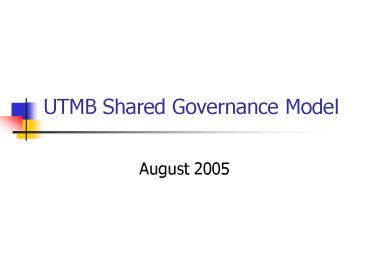UTMB Shared Governance Model - PowerPoint PPT Presentation
1 / 23
Title:
UTMB Shared Governance Model
Description:
... and cabinet structure ... Nursing Cabinet. Management/Staff Partnership Model (Unit) Nursing ... Nursing Cabinet confirms appointments to councils ... – PowerPoint PPT presentation
Number of Views:2176
Avg rating:3.0/5.0
Title: UTMB Shared Governance Model
1
UTMB Shared Governance Model
- August 2005
2
Development of Model
- September 2001 retreat by members of nursing
committees and advisory groups - Proposed council and cabinet structure
- Magnet Task Force retreat to identify Magnet
criteria to be assigned to each group - Timeline for rollout of model developed
3
Development of Model (cont)
- February-May 2002 started the six Nursing Service
Councils and updated Management Council - June 2002-May 2003 started department councils
(e.g. Critical Care, Greater Med/Surg) - July 2003 started development of SG councils at
the unit level
4
Development (cont)
- October 2003 Practice Retreat identified
really shared governance at the unit level as
one of the top three priorities for Nursing at
UTMB - October 2003 May 2004 development and
implementation of unit shared governance councils
under direction of SG TF
5
Goal of Shared Governance Model
- Transform hierarchical model to a participative
model - Improve clinical care, nursing satisfaction,
patient satisfaction, patient outcomes through
Nurse Clinician involvement
6
Success of Shared Governance
- Change structure
- Increased information sharing
- Keeping patients 1
- Skill development of clinical practitioners and
management staff - Resources allocated consistent with stated values
7
Previous Hierarchical Model
8
Management/Staff Partnership Model (Nsg Svc)
Nursing Service Councils
Nursing Cabinet
Department Councils
Unit Councils
9
Management/Staff Partnership Model (Unit)
Patient/Family Focus
10
Council Purpose/Focus
Each council will have a specific purpose or
focus .
11
Nsg Svc Council Purpose/Focus
Quality Patient Care Quality, Patient Outcomes
Quality Improvement in
Nursing Recruitment Retention provide NC
perspective on selection and retention
of staff to meet targets of
turnover rate and vacancy rate 10
or less Workplace/Environment Interpersonal
and physical environment issues
12
Nsg Svc Council Purpose/Focus (cont)
Education assure that staff have access to
education necessary to support their job
performance Responds to needs identified by
other councils Practice Standards of Care,
compliance with regula- tory standards,
fiscal and human resources to
provide care, practice issues Research
Documenting our clinical practice that is
research based, promoting nursing
research, practice guidelines, link
quality research
13
Council Membership (all levels)
- 50 or more Nurse Clinicians (exception
Management Council) - Co-chaired by a member of Management Council or
other nurse leader and a Nurse Clinician - Potential members apply for council membership
- Nursing Cabinet confirms appointments to councils
14
Representation on Councils
- Attempt to represent all clinical areas on
councils but recognize that once individuals are
members of councils, they represent all nurses in
the organization and need to have the broadest
view possible to assure that any council actions
will be in the best interests of most nurses in
the organization.
15
Management Council
- Membership is all NM, PM, DONs, plus 2 Nurse
Clinicians - Nurse Clinicians from Nursing Cabinet will serve
on this council
16
Cabinet Membership
- Cochairs of councils
- CNO
- Director of Nursing Practice
- NC reps to Management Council
- Project Director for Magnet/SG
- Co-chaired by CNO and Project Director
17
Council Work
- Make decisions regarding nursing standards and
practice - Collaborate with other groups (e.g. Pharmacy
Nursing Committee) - Share information
- Utilize subcommittees to do work
- Contribute evidence for recognition of nursing
excellence (e.g. Magnet criteria) - Report monthly activities to Cabinet
18
Cabinet Work
- Set Policy
- Share info with councils
- Refer issues to appropriate councils for action
- Track council actions to determine if annual
charges are completed - Review monthly activity of Councils
- Advise CNO
19
Roles
- Clinical Nurses are accountable for professional
practice
- Management is accountable for environment,
resources needed to support professional practice
20
Skills/Knowledge Needed
- Staff Needs
- System Thinking
- Meaning of Ownership
- How to Make Change
- Management Needs
- Facilitate Systems of Care
- Support Staff Development
- Self Development
21
Whats Next
- Evaluation of model by a short term task force
- Assess effectiveness and recommendations for
further development for UTMB Nursing Shared
Governance
22
Note
- UTMBs Nursing Shared Governance model is based
primarily on the work of Tim Porter-OGrady and
associates over the past 30 years. Detailed
references and support materials are available
from Project Director.
23
Contact Information
- Ellarene Duis
- RN, PhD, CNAA, BC
- Project Director Magnet Recognition/Shared
Governance - erduisni_at_utmb.edu
- Ext 28390































